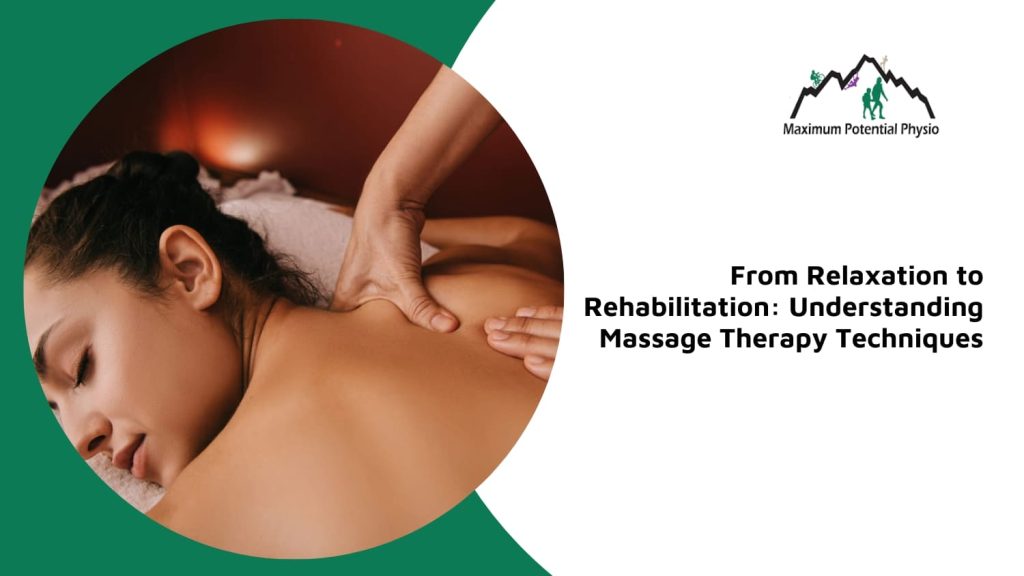From Relaxation to Rehabilitation: Understanding Massage Therapy Techniques

Massage therapy is more than just a luxury—it’s a powerful tool for managing pain, enhancing recovery, and improving overall health. With a wide variety of techniques available, each tailored to specific goals and symptoms, it can be challenging to know which type of massage is right for you. In this blog, we’ll break down the most common types of massage therapy, how they work, and the conditions they’re best suited to address. Whether you're seeking stress relief, muscle recovery, or targeted treatment for chronic tension, understanding these options can help you make informed decisions about your care.
Commonly Used Types of Massage Therapy
There are several types of massage therapy, each with a distinct purpose and technique. The most commonly practiced methods include:
- Swedish Massage: Known for its long, flowing strokes and gentle pressure, Swedish massage is ideal for relaxation and stress reduction.
- Deep Tissue Massage: This method targets deeper muscle layers and connective tissue, often used to treat chronic muscle pain and tension.
- Sports Massage: Specifically designed for athletes and active individuals, sports massage helps improve performance and speed up recovery.
- Trigger Point Therapy: Focuses on tight areas within muscle tissue that refer pain to other parts of the body.
- Myofascial Release: A gentle, sustained pressure technique that targets the fascia, the connective tissue surrounding muscles.
- Lymphatic Drainage Massage: A light pressure massage aimed at promoting the flow of lymph fluids and reducing swelling.
- Prenatal Massage: Tailored for pregnant individuals, this massage alleviates discomfort associated with pregnancy.
- Thai Massage: Combines assisted stretching and pressure techniques to improve mobility and energy flow.
Each of these styles has unique benefits depending on your symptoms, goals, and health history.
Swedish vs. Deep Tissue Massage: What’s the Difference?
Although they may seem similar at first glance, Swedish and deep tissue massage serve different purposes and use different techniques:
- Swedish Massage is designed to promote full-body relaxation. It uses long, gliding strokes, kneading, and circular movements with light to moderate pressure. This technique increases circulation, reduces stress, and promotes overall well-being.
- Deep Tissue Massage, on the other hand, involves slower strokes and more focused pressure on areas of chronic tension. It is especially effective for those experiencing muscular pain, sports injuries, or postural issues.
While Swedish massage is great for mental and physical relaxation, deep tissue massage is better suited for addressing structural muscle problems.
Sports Massage Therapy Explained
Sports massage is a specialized approach designed to support the physical demands placed on athletes and active individuals. It aims to improve performance by enhancing flexibility, promoting circulation, and reducing muscle tension. Many athletes use it as part of their regular training to minimize recovery time after intense physical exertion and to maintain peak function. In addition to boosting recovery, sports massage also plays a preventative role. It helps identify and address muscular imbalances or tightness before they develop into more serious injuries.
Those already managing conditions such as sprains, strains, or overuse injuries often incorporate sports massage into their rehabilitation to restore optimal function. Techniques used in sports massage often include stretching, deep tissue manipulation, and compression. These can be applied before athletic events to warm up muscles and improve readiness, or afterward to reduce soreness and support faster healing. Whether used proactively or reactively, sports massage therapy is an effective tool for maintaining muscular health and preventing injury.
When Should You Choose Trigger Point Therapy?
Trigger point therapy is ideal for individuals experiencing localized pain or referred pain—pain that starts in one part of the body but is felt in another. This technique:
- Targets specific points of tight muscle fibres that form after injury or overuse.
- Helps release knots that contribute to headaches, neck pain, shoulder tension, and back discomfort.
- Uses pressure and release cycles to alleviate muscle spasms and improve range of motion.
It’s especially beneficial for those with myofascial pain syndrome, fibromyalgia, or chronic muscle tension.
What to Know About Myofascial Release
Myofascial release focuses on relieving tension in the fascia—the web-like connective tissue that surrounds muscles and organs. Unlike traditional massage, this technique involves:
- Applying sustained, gentle pressure to restricted areas.
- Holding the stretch until the fascia begins to soften and release.
- Enhancing movement and reducing discomfort in tight or injured areas.
This therapy is useful for individuals with chronic pain, restricted mobility, postural issues, or those recovering from surgery. It’s also common in rehabilitation settings for conditions like scoliosis or soft tissue injuries.
Prenatal Massage: Is It Safe During All Stages of Pregnancy?
Prenatal massage is generally safe throughout most stages of pregnancy when provided by a therapist specifically trained in pregnancy care. It can offer meaningful relief from the physical discomforts associated with pregnancy, including lower back pain, joint pressure, and muscular tension. Many pregnant individuals also report improved sleep, decreased anxiety, and better circulation following regular sessions. Swelling in the legs and feet, a common concern in later stages of pregnancy, may be reduced with targeted massage techniques. However, prenatal massage should always be discussed with your healthcare provider, particularly if you’re in your first trimester or have a high-risk pregnancy.
Therapists trained in prenatal care use specially designed support cushions and often position clients on their sides to maintain safety and comfort throughout the session. These modifications help ensure that both the individual and baby are protected while still allowing the therapeutic benefits of massage to be delivered effectively.
Benefits of Hot Stone Massage Therapy
Hot stone massage therapy involves placing smooth, heated stones on specific parts of the body, often combined with traditional massage techniques. This form of massage is known for its deeply relaxing effects and ability to ease both physical and emotional tension.
Benefits include:
- Muscle Relaxation: The warmth of the stones helps loosen tight muscles, making it easier for the therapist to perform deeper work.
- Improved Circulation: Heat promotes better blood flow, which can support healing and reduce fatigue.
- Stress Reduction: The combination of heat and soothing massage can help lower stress hormones and promote a sense of calm.
- Pain Relief: Those with chronic muscle tension, arthritis, or fibromyalgia may find hot stone massage effective in reducing discomfort.
Combining Different Massage Types in One Session
It is common for massage therapists to combine different techniques into a single session, especially when a client presents with a variety of symptoms or goals. Rather than sticking to one style, therapists often customize their approach based on the individual’s physical condition, preferences, and therapeutic needs. For example, a massage might begin with gentle Swedish strokes to induce relaxation, followed by focused deep tissue work on areas of muscle tightness. If specific trigger points are present, the therapist may use targeted pressure to release knots and restore movement.
Some sessions also include assisted stretching or joint mobilization to enhance flexibility and function. This blended approach allows the therapist to work on both surface-level tension and deeper muscular patterns within the same treatment. By adjusting the techniques used throughout the session, the therapist can deliver a more comprehensive and effective experience tailored to the client’s body and concerns.
Managing Chronic Pain or Tension: Recommended Types of Massage
Several massage therapy styles are designed to help manage chronic pain and muscle tension. These include:
- Deep Tissue Massage: Targets deeper layers of muscle and connective tissue to release chronic knots and adhesions.
- Trigger Point Therapy: Focuses on specific points of muscle tightness that cause referred pain in other areas.
- Myofascial Release: Involves gentle sustained pressure to release fascial restrictions and improve mobility.
- Neuromuscular Therapy: Helps with nerve-related pain by addressing muscle imbalances and circulation.
These types of massage can reduce pain sensitivity, increase range of motion, and improve quality of life when used consistently.
How Often Should You Get Massage Therapy Based on the Type?
The frequency of massage therapy depends on individual health goals, the type of massage received, and any underlying conditions being addressed. For general stress relief or relaxation, a session every three to four weeks is typically sufficient to maintain well-being. Those dealing with chronic pain, tension, or musculoskeletal imbalances may require more frequent visits, often once a week or every other week, especially during periods of heightened discomfort.
Athletes or physically active individuals benefit from regular treatments scheduled around their training cycles, which could mean biweekly or monthly sessions depending on intensity. During pregnancy, massage can be especially helpful in the second and third trimesters, with many choosing to book appointments every two to four weeks to manage swelling, back pain, and fatigue.
Ultimately, your massage therapist will evaluate your specific needs and symptoms to recommend a schedule that best supports your recovery and health objectives.
Find the Right Kind of Treatment for You
The right massage therapy can make a significant difference in how your body feels and functions. Whether you're dealing with chronic tension, recovering from an injury, or simply looking to relax, understanding the different types of massage can help guide your treatment choices.
At Maximum Potential Physiotherapy in Calgary NW, our team of experienced professionals can tailor a massage therapy plan that aligns with your unique needs and goals. Reach out today to book an appointment and start your journey toward improved comfort, mobility, and well-being.

